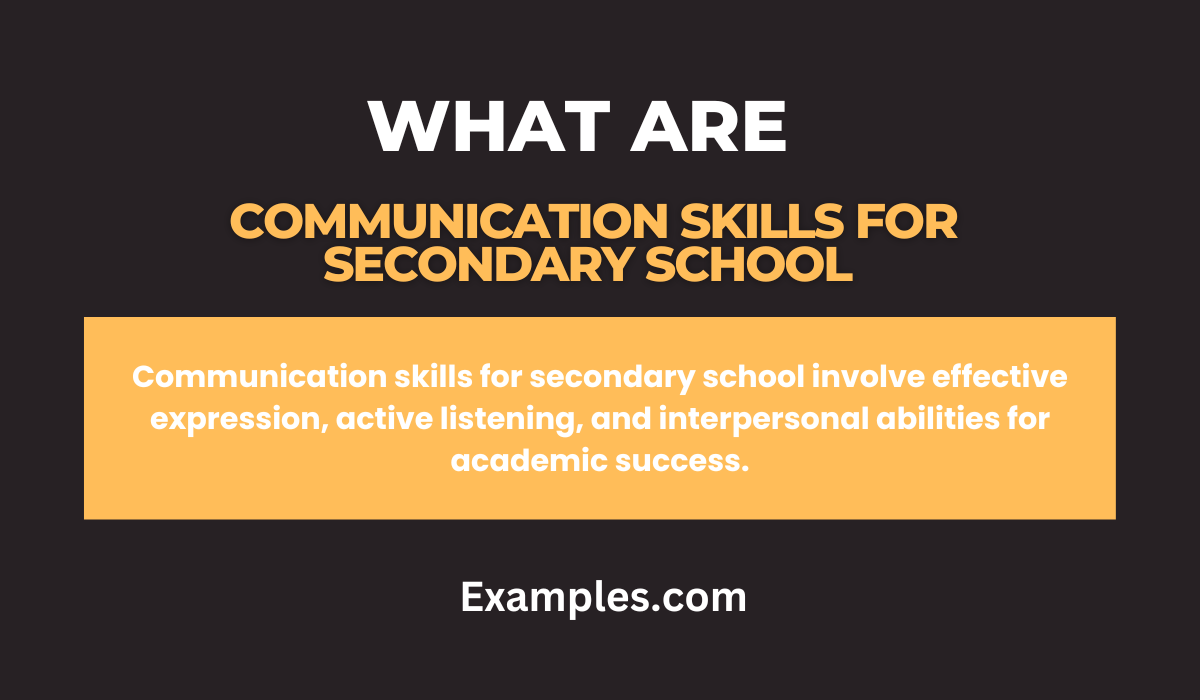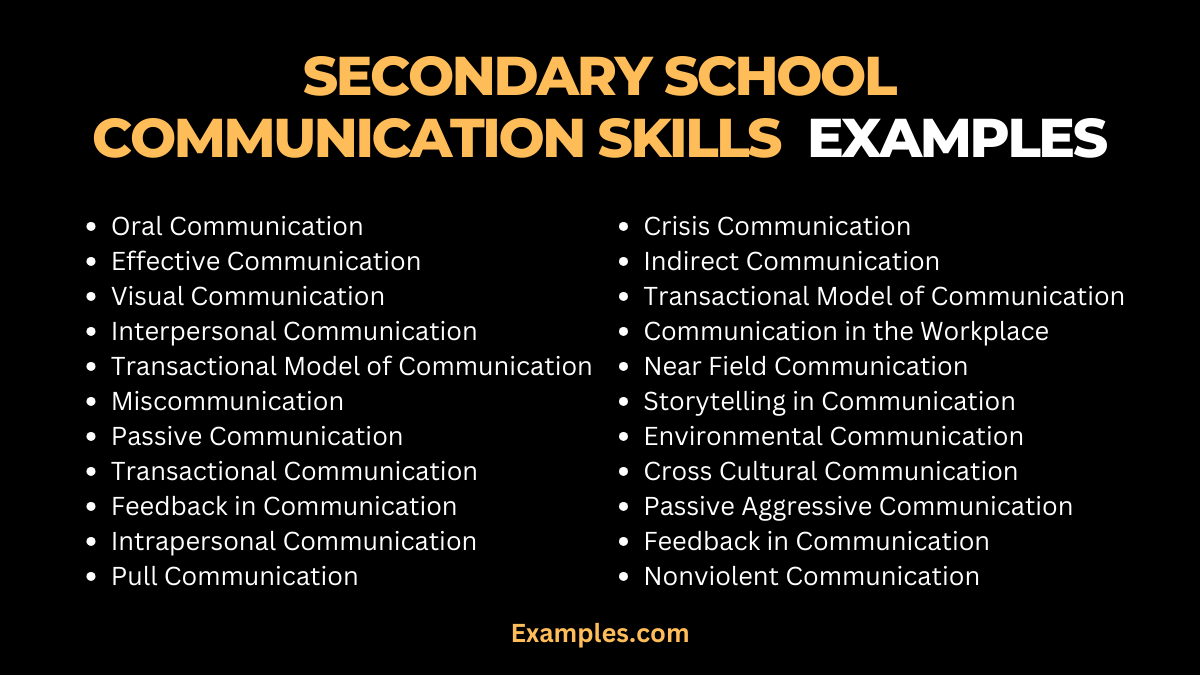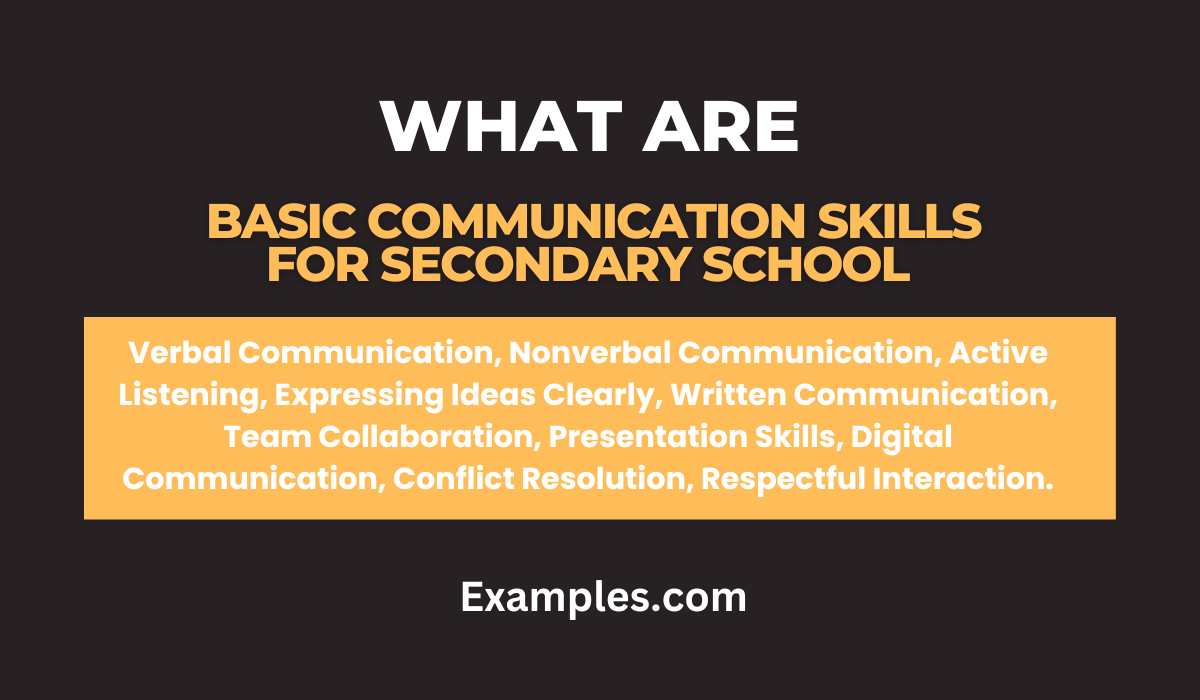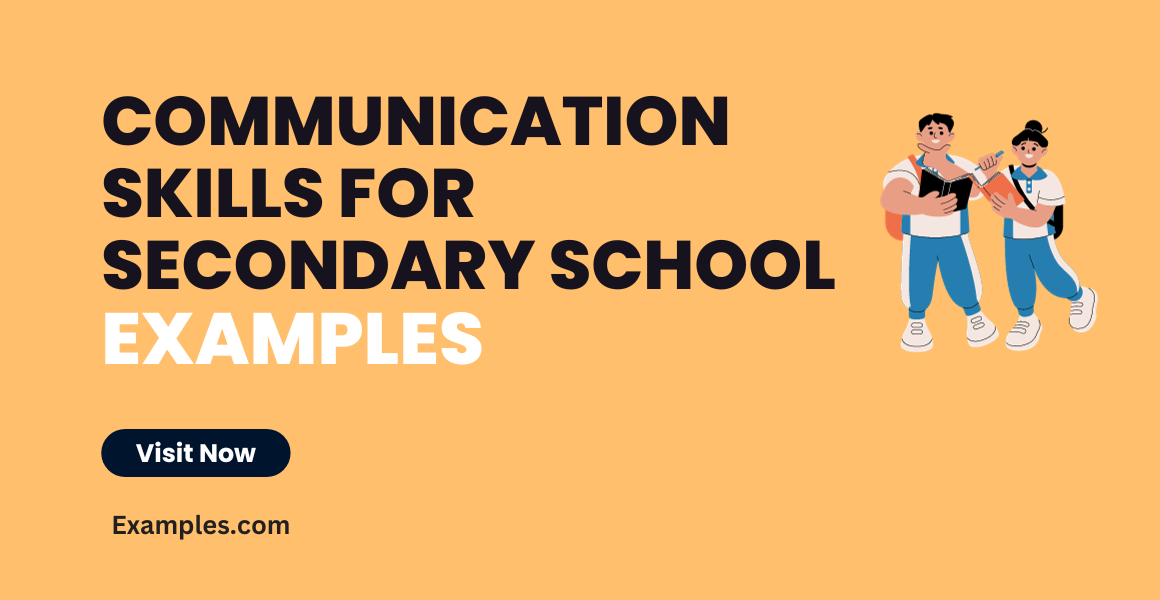19+ Communication Skills for Secondary School Examples
Unlock the gateway to academic and social excellence with our comprehensive guide on Communication Skills for Secondary School. Enhance your understanding through practical examples, tips, and real-world insights that empower students to navigate the dynamic challenges of secondary education with finesse.
What are Communication Skills for Secondary School?

Communication Skills for Secondary School encompass the ability to express ideas, thoughts, and emotions effectively, fostering clear understanding and connection. It involves verbal and nonverbal communication, active listening, and interpersonal skills, forming the foundation for academic success and positive social interactions.
30 Communication Skills for Secondary School Examples

Unlock success in secondary school with honed communication skills. Explore the art of oral communication through class discussions and presentations. Embrace the power of written communication in assignments and projects. Navigate the intricate realm of nonverbal communication, mastering cues and gestures. Our article delves into the why and how of communication skills, offering examples and tips for students. Elevate academic prowess and future prospects with this comprehensive guide tailored for secondary school success. Communication skills for secondary school are essential for students to excel academically and socially. These skills encompass verbal and nonverbal abilities, fostering effective expression and understanding. Here are 30 examples to enhance secondary school communication skills:
- Oral Communication: Mastering the art of delivering clear and engaging presentations during class discussions enhances oral communication skills.
- Effective Communication: Conveying ideas with precision and impact, students showcase effective communication in group projects.
- Visual Communication: Creating informative posters and visual aids to aid in conveying complex concepts is an essential aspect of visual communication.
- Interpersonal Communication: Navigating group dynamics and building strong connections with peers exemplify robust interpersonal communication.
- Transactional Model of Communication: Clarifying project objectives and ensuring understanding through structured communication embodies the transactional model of communication.
- Miscommunication: Identifying and rectifying instances of misunderstanding in academic discussions helps mitigate the impact of miscommunication.
- Passive Communication: Recognizing the impact of passive communication in discussions and adjusting communication style to be more assertive.
- Feedback in Communication: Offering constructive feedback on a peer’s written work contributes to a culture of continual improvement in communication skills.
- Transactional Communication: Collaborating seamlessly with peers on a joint project, ensuring a balanced exchange of ideas is an application of transactional communication.
- Intrapersonal Communication: Reflecting on personal thoughts and emotions before engaging in discussions enhances intrapersonal communication.
- Pull Communication: Actively seeking input from classmates by posing thought-provoking questions during group activities.
- Crisis Communication: Effectively managing group dynamics during challenging academic tasks to ensure a smooth resolution exemplifies crisis communication.
- Indirect Communication: Conveying ideas subtly through gestures or body language during classroom discussions demonstrates the skill of indirect communication.
- Transactional Model of Communication: Ensuring all team members are aligned with project goals through structured communication.
- Effective Communication in the Workplace: Crafting professional emails and reports for collaborative assignments prepares students for future workplace effective communication.
- Communication Accommodation Theory: Adjusting communication style to connect with classmates from diverse cultural backgrounds fosters an understanding of communication accommodation theory.
- Near Field Communication: Actively engaging in close collaboration during group projects fosters a sense of near field communication.
- Transactional Communication: Collaborating seamlessly with peers on a joint project, ensuring a balanced exchange of ideas is an application of transactional communication.
- Storytelling in Communication: Presenting historical events in a narrative format during assignments enhances understanding through storytelling in communication.
- Environmental Communication: Collaboratively designing an informative poster to communicate environmental issues fosters awareness through environmental communication.
- Cross Cultural Communication: Discussing diverse perspectives in a debate on current affairs demonstrates a proficiency in cross-cultural communication.
- Passive Aggressive Communication: Understanding and addressing the negative impact of passive-aggressive language during group discussions enhances passive-aggressive communication.
- Feedback in Communication: Offering constructive feedback on a peer’s oral presentation skills contributes to a culture of continual improvement in communication skills.
- Nonviolent Communication: Resolving conflicts diplomatically and fostering understanding without resorting to aggression is an example of nonviolent communication.
- Professional Communication: Practicing professionalism in written and spoken interactions, such as addressing teachers and peers respectfully.
- Communication Process: Mapping out the steps of collaborative assignments to understand the flow of effective communication.
- Lateral Communication: Facilitating teamwork by encouraging lateral communication among peers during group projects.
- Empathetic Communication: Expressing understanding and support to classmates facing academic challenges demonstrates empathetic communication.
- Transactional Communication: Ensuring all team members contribute equally to group projects to maintain a balanced communication flow.
- Competency Communication: Showcasing individual strengths during a class-wide competition by effectively communicating achievements and skills.
Communication Skills for Secondary School Students Examples
Unlocking success in secondary school requires more than academic prowess. Sharpen your edge with crucial communication skills. Master the art of Intrapersonal Communication through self-reflection, enhancing emotional intelligence. Develop Near Field Communication by actively engaging in group projects, fostering collaboration. Embrace the power of Visualization Communication by creating mind maps for complex subjects, aiding comprehension. Elevate your written communication with precision in essays and reports, showcasing your grasp of language.
- Effective Communication: Delivering a well-structured presentation during class discussions.
- Transactional Communication: Collaborating seamlessly with peers on a joint project.
- Interpersonal Communication: Navigating group dynamics during extracurricular activities.
- Crisis Communication: Handling unexpected challenges with poise during exams.
- Communication Accommodation Theory: Adapting communication style to connect with diverse classmates.
- Competency Communication: Showcasing subject mastery through clear explanations.
- Interactive Model of Communication: Actively participating in interactive learning sessions.
- Feedback in Communication: Providing constructive feedback on peer presentations.
- Indirect Communication: Using subtle cues to convey ideas during class discussions.
- Storytelling in Communication: Making lessons memorable through engaging narratives.
Communication Skills for Secondary School Examples at Work
Transitioning from school to the workplace demands a refined set of communication skills. Learn the nuances of Professional Communication by crafting polished emails and reports. Navigate corporate environments with finesse using Lateral Communication, fostering collaboration across departments. Harness the power of Digital Communication for effective virtual teamwork. Develop Empathetic Communication to build strong working relationships. Mastering these skills ensures a seamless transition from the classroom to a successful career.
- Communication Strategy: Developing a clear plan for team communication on a project.
- Conflict Resolution Communication: Mediating disagreements among team members diplomatically.
- Communication in Healthcare: Conveying complex medical information to patients with clarity and empathy.
- Transactional Model of Communication: Ensuring all team members are on the same page regarding project goals.
- Global Communication Challenges: Addressing cultural differences in a multinational team.
- Environmental Communication: Advocating for sustainable practices within the workplace.
- Persuasive Communication: Convincing colleagues of the viability of a new idea or approach.
- Communication Goals: Setting clear communication objectives for team projects.
- Telecommunications: Utilizing various digital platforms for remote collaboration.
- Cross Cultural Communication: Bridging cultural gaps to enhance global business partnerships.
Why are Communication Skills Important in Secondary School?
Communication skills form the backbone of success in secondary school for several compelling reasons:
- Academic Achievement: Clear expression aids comprehension and academic performance.
- Social Integration: Effective communication fosters positive relationships with peers and teachers.
- Future Employability: Employers value strong communication skills in various professions.
- Confidence Building: Expressing ideas boosts self-assurance in academic and social contexts.
- Collaborative Learning: Facilitates effective teamwork and group project success.
- Conflict Resolution: Essential for navigating interpersonal challenges in school and beyond.
- Preparation for Higher Education: Builds a foundation for advanced academic and professional communication.
- Life Skills Development: Instills skills crucial for personal and professional success post-education.
What are the Basic Communication Skills for Secondary School?
In secondary school, mastering fundamental communication skills is pivotal for academic success and personal growth. Key skills include:

- Verbal Expression: Clear articulation of thoughts and ideas.
- Active Listening: Engaging attentively to comprehend others.
- Presentation Skills: Confidence in delivering ideas effectively.
- Digital Communication: Responsible use of online platforms.
- Collaboration: Working harmoniously in group projects.
- Conflict Resolution: Skills to address disagreements diplomatically.
- Nonverbal Communication: Understanding and utilizing body language.
- Empathy: Recognizing and understanding others’ emotions.
- Critical Thinking: Analyzing information and expressing opinions.
- Effective Writing: Clear and coherent written communication.
Different Ways to Improve Communication Skills for Secondary School
Enhancing communication skills in secondary school involves a multifaceted approach. Here are diverse strategies to bolster students’ proficiency:
- Participation in Extracurricular Activities: Engage in clubs, debates, or drama to develop both verbal and nonverbal communication skills.
- Public Speaking Opportunities: Encourage students to participate in public speaking events, fostering confidence and articulation.
- Peer-to-Peer Collaborations: Emphasize collaborative projects, encouraging students to express ideas and work together effectively.
- Active Listening Exercises: Integrate activities that enhance active listening skills, crucial for understanding diverse perspectives.
- Storytelling Workshops: Cultivate narrative skills through storytelling workshops, promoting creativity and effective expression.
- Role-Playing Scenarios: Incorporate role-playing exercises to simulate real-life communication challenges and improve problem-solving abilities.
- Digital Communication Proficiency: Equip students with digital literacy skills, including email etiquette and online collaboration platforms.
- Debate and Discussion Forums: Create platforms for structured debates and discussions to refine argumentative and persuasive communication.
- Critical Thinking Exercises: Integrate critical thinking activities that require students to articulate and defend their viewpoints.
- Mock Interviews: Conduct mock interviews to prepare students for future professional interactions, enhancing communication in various contexts.
Tips for Effective Communication Skills for Secondary Schools
Empower secondary school students with practical tips to refine their communication skills for academic and personal success:
- Active Participation: Encourage students to actively participate in class discussions, fostering engagement and confidence.
- Constructive Feedback: Provide constructive feedback on communication efforts, focusing on strengths and areas for improvement.
- Effective Use of Visual Aids: Teach students how to incorporate visual aids in presentations for clearer communication.
- Encourage Reading and Writing: Promote reading and writing activities to enhance vocabulary and articulate expression.
- Digital Etiquette: Emphasize responsible digital communication, addressing the nuances of online interactions.
- Body Language Awareness: Educate students on the importance of positive body language in conveying messages effectively.
- Mindful Listening: Cultivate mindful listening skills, emphasizing understanding before formulating responses.
- Peer Review Sessions: Introduce peer review sessions for students to evaluate and provide feedback on each other’s communication.
- Cultural Sensitivity: Foster awareness of cultural differences and the impact on communication, promoting inclusivity.
- Real-world Applications: Connect communication skills to real-world scenarios, showcasing their relevance beyond the classroom.
In conclusion, this comprehensive guide on Communication Skills for Secondary School equips students with the tools to navigate the intricacies of effective communication. By exploring diverse strategies, practical examples, and valuable tips, students are empowered to excel academically, collaborate seamlessly, and develop lifelong skills essential for success in secondary education and beyond.



